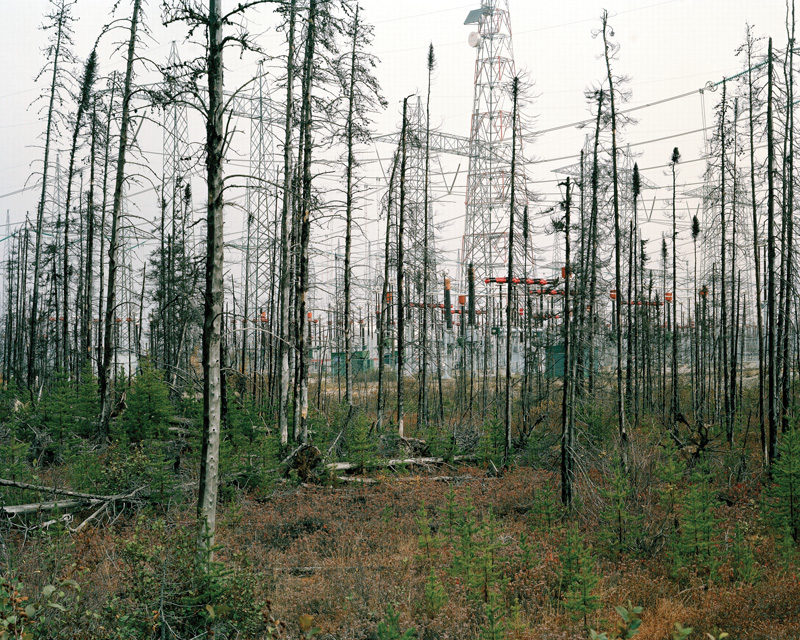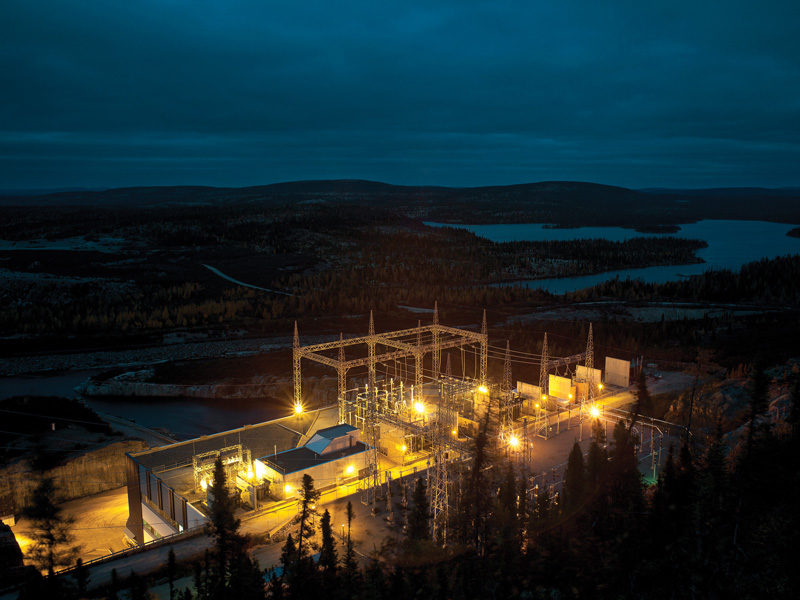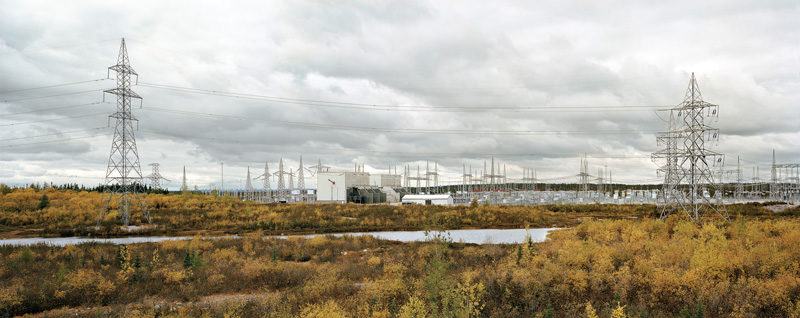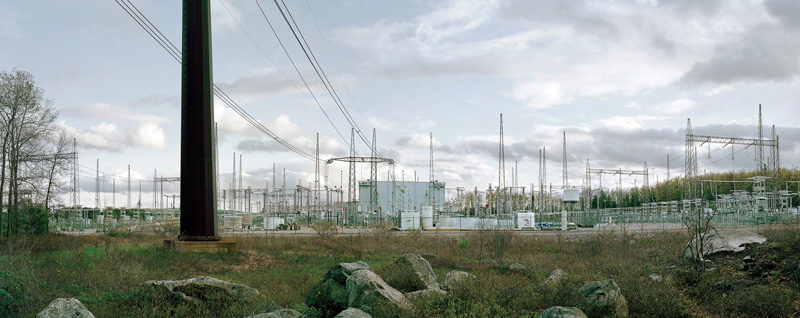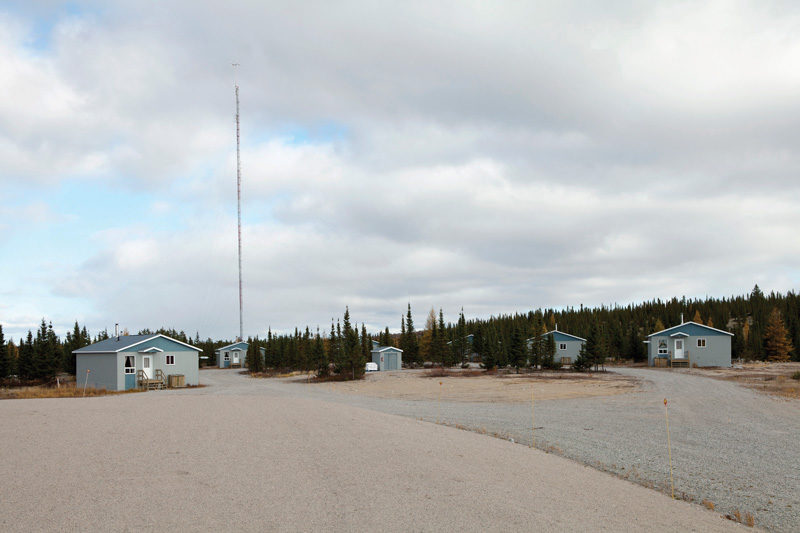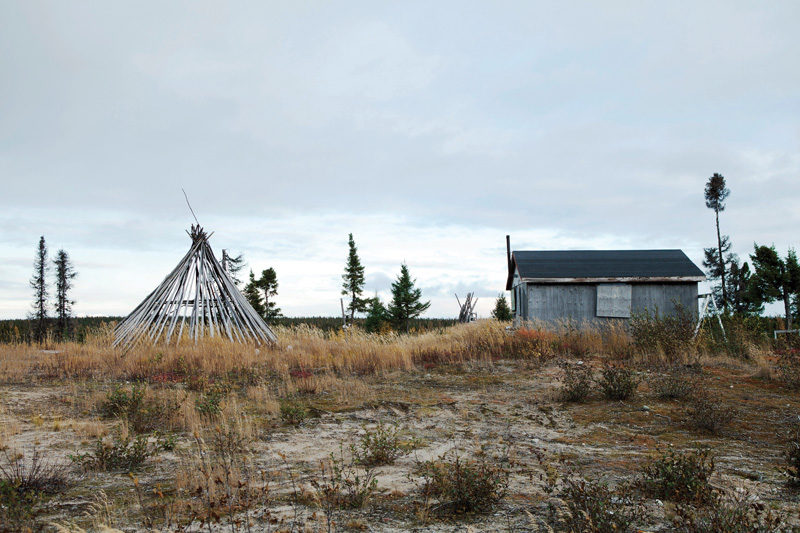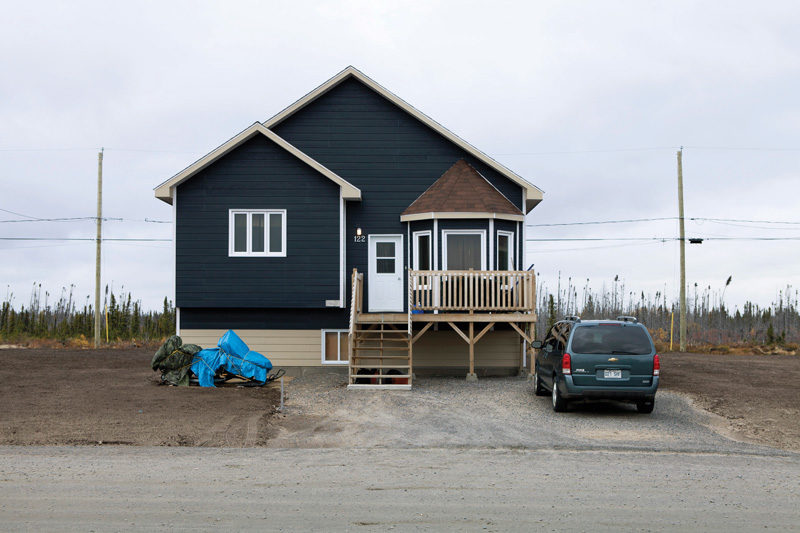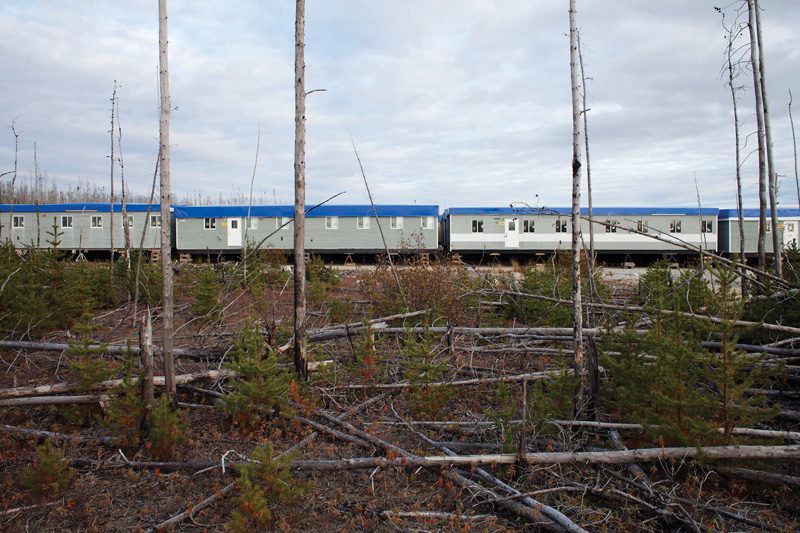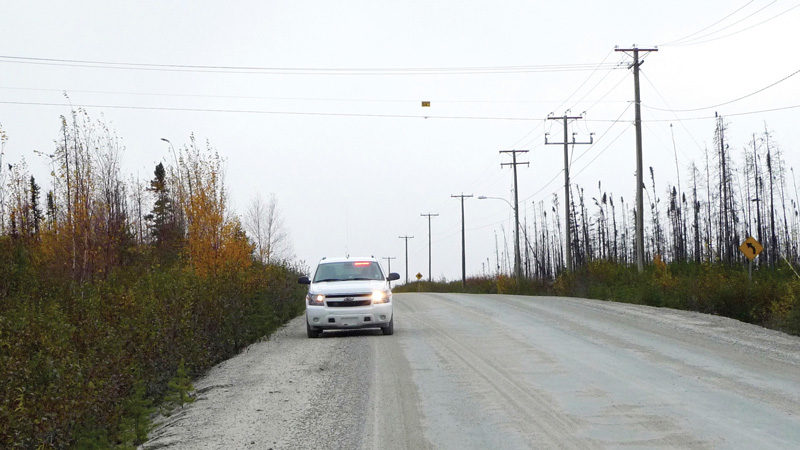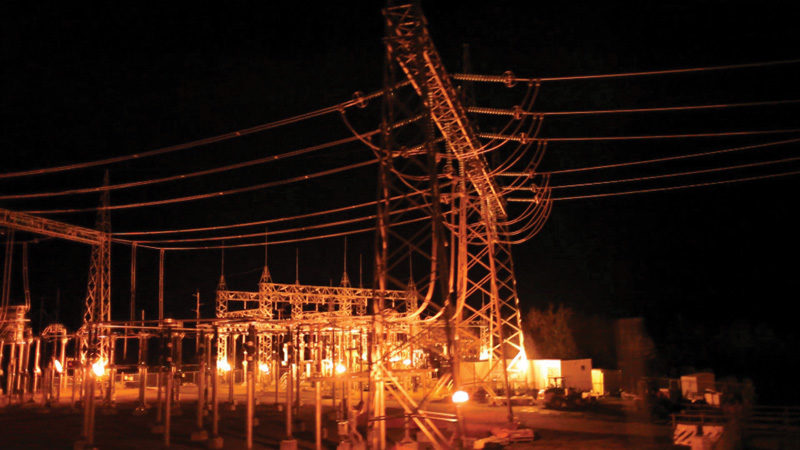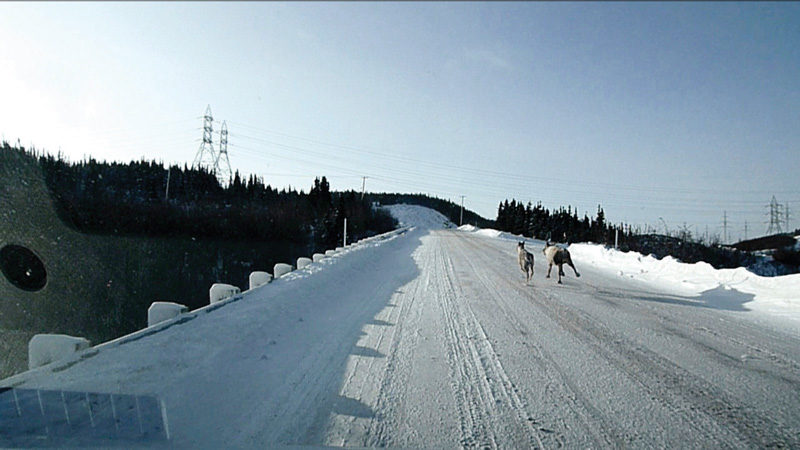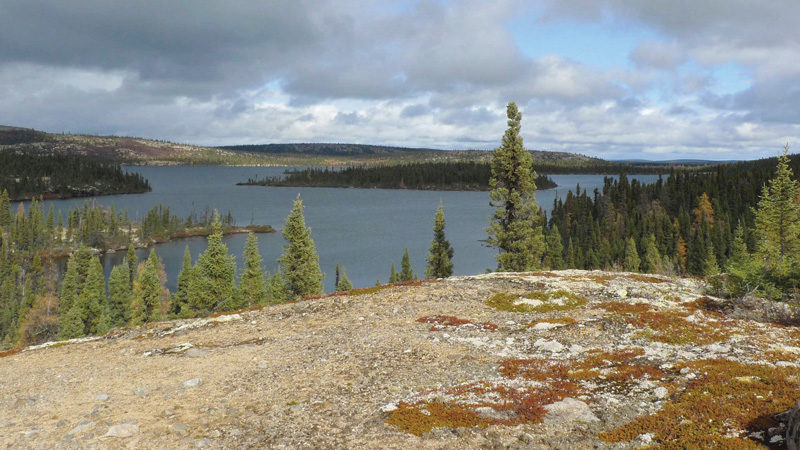[Fall 2012]
This picture is of the Brisay station on the La Grande River, situated at the end of the Trans-Taiga Road. Such a mythic vision of a territory at the top of the world to be discovered, explored, and exploited remains deeply anchored in Southern conceptions. For many Quebecers who go to James Bay as tourists, such visions still evoke the ultimate goal of a voyage across new lands marked by large collective projects. The end of the road: the meeting of the end and the beginning. Then come two groups of colour prints that place reference points on the northern space. The first pre-sents three views of power relays in the hydroelectric transmission line that runs from Radisson to Boston – a trajectory whose source is in the inexhaustible Northern reservoir of energy and flows down south from it. The rigour of the voyage is, here, matched by the precision with which Kneubühler structures his images of landscapes transformed by industrialization and development. Each picture overlays the natural and the constructed in a flattened pictorial space in which taiga and electric pylons intermingle. The tight framings and eye-level views differentiate these pictures from the heroic and triumphal renderings of the James Bay projects produced by official propaganda. It is not that Kneubühler is taking sides or claiming the truth; his only interests are description and the accuracy of the observation.
Whereas the images of power stations portray the superimposition of built structures on the natural environment, the six photographs in the group called Nomadic Settlements show how difficult it is for Northern and Southern cultures to cohabit. These images present buildings ranging from temporary housing for Southern workers to traditional Aboriginal housing to outfitters’ facilities designed for recreational purposes for wealthy fishermen and hunters. All of these forms of habitation are made for immediate functionality, and they mark a territory configured not only by the natural environment and necessity but also by groups of practices arising from culture, politics, economics, technology, and history. Thus, each of the images in the grouping mixes Aboriginal vernacular architecture with built structures imported from the South and transplanted into the Northern habitat. Kneubühler is not interested in bringing out the specificity of the location or emphasizing a group of specific features that would be the basis of an immediately perceptible and intelligible uniqueness and identity. The frontal display, the absence of aesthetic effects, and the clean rendering of the images result in a flattened view of the site: it becomes a generic space in which forms inherited from pure functionality interact and facilities not specific to a particular culture are found. It is a non-space in which “here” and “there,” “everywhere” and “nowhere” lose their meaning – a non-space in which the lines between the universal and the specific are erased.
Two conceptions of occupation of the territory cohabit and often confront each other in northern Quebec: that of the Aboriginals, who are the only stable population living on and using the resources of the land, with which they have woven particular links related to the seasons and their needs, and that of the Southerners, who occupy and exploit the territory with immediate profitability as their only guide. In this regard, the presentation of the James Bay and Northern Quebec Agreement opens new perspectives. This voluminous piece of legislation, the result of negotiations between the Government of Quebec and the northern Aboriginal populations, established concrete parameters for development of natural resources and assigned territorial rights to the territory’s first inhabitants. The notion of territoriality is capital: “Territoriality becomes more than ‘land,’ it puts people into contact in an identified space, via the links of the past, emotions, economic interests, and need for political security – thus, culture. Territoriality means that an area ceases to be solely physical.”2 In the same way that the legal document frames and contextualizes the photographs that surround it by giving them historical weight, its currency is underlined by images of one of the power stations on a live feed via a webcam. This uninterrupted series of pictures taken moment by moment breaks the historical fixity by installing a fluid temporality that flows imperceptibly through the hours, days, and climatic conditions.
In a way, the video Currents is the keystone of the entire grouping because it poetically conveys the major themes sketched out in the still images and documents presented. A sort of road movie that opens on a still shot of a Hydro-Québec car stopped on the Trans-Taiga Road and ends at the Brisay power station, the video is composed of a series of short sequences, punctuated by blackouts and intertitles, of shots of caribou on the road, trailers transporting goods from the South to the North, facilities for Southern workers, and, finally, Aboriginal dwellings – chapters united by the notions of nomadism and migratory paths. Instinct and the quest for pastures that will guarantee abundant food guide the caribou on the long migratory routes from north to south in the fall and from south to north in the spring. These important seasonal migrations have already been disrupted by the construction of roads needed for hydroelectric development, which not only irrevocably changes the landscape and topography of the area but sets obstacles on the ancestral pathway of animals whose survival depends entirely on the resources in the natural environment.
Southerners, for their part, erect facilities on the model of Southern structures in order to ensure the wellbeing of the new nomads – workers who migrate from the South to the North – for the sole purpose of making money and rarely for sustainable development, as evidenced by the once-prosperous towns of Gagnon and Schefferville in Nouveau-Québec, which had their moments of glory and prosperity between the 1950s and the 1980s. Completely dependent on iron-ore mining operations, Schefferville was, for all practical purposes, abandoned in 1982, when Iron Ore of Canada closed its mine. Only 231 people lived there in 2011, according to that year’s census. Gagnon was razed in 1985, when the mine operated by Québec Cartier Mining closed. These utopian towns – structured as microcosms based on Southern values to see to every human need – butted up against the fundamental value of rootedness in a culture that is not material and became simply transitional sites. When they were abandoned, all that was left was ruins that made a lasting impression on the natural environment.
The sequence introduced by the word “Relocated” is composed of a still image of an Aboriginal hunter holding a dead animal and a filmed pan of the car in motion among dwellings occupied by Aboriginals who have been displaced by large construction sites. The soundtrack counterpointing the images is a conversation with a woman who says, “There was no village before. The Aboriginals were nomads” (our translation). Replacing the traditional Aboriginal way of life are houses transplanted from the South into a no-man’s-land from which all trace of the nurturing natural environment has been erased. This reprise, in another register, of the images in Nomadic Settlements shows that “the ‘Amerindian North’ is now a mental ecumene, which may be why it is economically poor compared to societies in which abundance seems to represent a better type of objective. Between the North of the great capitalists and the Aboriginal North the difference is not only the volume of money but, above all, different levels among the priorities themselves.”3
Whereas Southern workers are in the North only temporarily and will return home after a relatively brief stay, leaving ghost towns behind them, it is the sedentarized Aboriginals, cut from their ancestral values and the accompanying sense of belonging, who will pay the heavy toll of acculturation. For them, the exploitation of resources and development of the territory offer no guarantee of social progress. Their ancestral way of life is reduced to a set of forms devoid of substance and relegated to a sort of no-man’s-land in which all cultures are the same and basic distinctions of identity disappear before the economic imperatives that are now the linchpin of community life. The Other is eaten away by the Same. The sequence titled Flow Control serves as a sort of conclusion and coda for the entire project. It opens on a map showing the sites of dams on the many watercourses that cross the North and the routes of transmission lines that carry the electricity to the South. Then a slow travelling shot at the end of the road stops at the gate barring entry to the Brisay power station, in front of which a uniformed security guard stands. The last shot is a lateral pan that slowly reveals the facilities of the power station and the reservoir that stretches out at its foot. The soundtrack, composed mostly of the sound of running water, gradually transformed into the crackling sound characteristic of high-tension lines, acquires here the full symbolism evoked by the video’s title: water current, electrical current, the flows of animal and human migrations that leave in their wake their share of contractions.
Translated by Käthe Roth
2 Louis-Edmond Hamelin, Échos des pays froids (Sainte-Foy: Les Presses de l’Université Laval, 1996), p. 269. (our translation).
3 Louis-Edmond Hamelin, Nordicité canadienne (Montreal: Éditions Hurtubise hmh, 1980), pp. 287–88. (our translation).
Born in Solothurn, Switzerland, Thomas Kneubühler has been living in Canada since 2000. In 2003, he completed a master’s degree in studio arts at Concordia University, Montreal. His work often deals with social issues and how technology is affecting people’s lives. His work has been presented in many exhibitions in both Europe and North America, in off-spaces as well as in galleries and in museums. “Under Currents” has been shown at the Québec Triennial 2011 at the Musée d’art contemporain de Montréal, and at the Swiss Art Awards exhibition in Basel 2012, where it was one of the award-winning projects. Thomas Kneubühler is represented by Patrick Mikhail Gallery. www.thomaskneubuhler.com
Pierre Dessureault is a historian of photography and independent curator. He has organized numerous exhibitions and published a large number of catalogues and articles on contemporary photography. He was editor of Nordicité (Éditions J’ai VU, 2010), a book featuring Quebec, Canadian, and Northern European photographers and essays by experts in art history and the human sciences.

